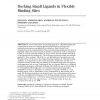Free Online Productivity Tools
i2Speak
i2Symbol
i2OCR
iTex2Img
iWeb2Print
iWeb2Shot
i2Type
iPdf2Split
iPdf2Merge
i2Bopomofo
i2Arabic
i2Style
i2Image
i2PDF
iLatex2Rtf
Sci2ools
JCC
1998
1998
Docking small ligands in flexible binding sites
: A novel procedure for docking ligands in a flexible binding site is presented. It relies on conjugate gradient minimization, during which nonbonded interactions are gradually switched on. Short Monte Carlo minimization runs are performed on the most promising candidates. Solvation is implicitly taken into account in the evaluation of structures with a continuum model. It is shown that the method is very accurate and can model induced fit in the ligand and the binding site. The docking procedure has been successfully applied to three systems. The first two are the binding of progesterone and 5-androstane-3,17-dione to the antigen binding fragment of a steroid binding antibody. A comparison of the crystal structures of the free and the two complexed forms reveals that any attempt to model binding must take protein rearrangements into account. Furthermore, the two ligands bind in two different orientations, posing an additional challenge. The third test case is the docking of ␣ Ž ...
| Added | 22 Dec 2010 |
| Updated | 22 Dec 2010 |
| Type | Journal |
| Year | 1998 |
| Where | JCC |
| Authors | Joannis Apostolakis, Andreas Plückthun, Amedeo Caflisch |
Comments (0)

